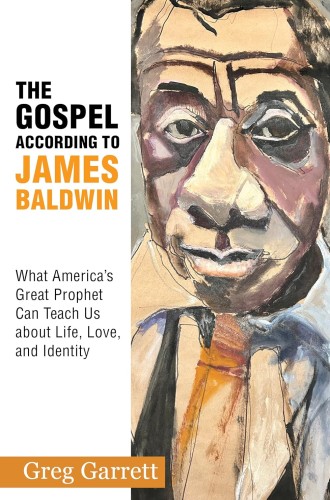Navigating James Baldwin’s legacy
Greg Garrett provides a road map for the terrain of the prophetic writer’s work and thought.

The Gospel According to James Baldwin
What America’s Great Prophet Can Teach Us about Life, Love, and Identity
Some months ago, inspired largely by this magazine’s content (see “Baldwin the exorcist,” November 2022), I declared for myself a Year of Baldwin: for 12 months, all of my nonfiction reading material would be the essays of James Baldwin and most of my fiction reading would be his novels. After a few months, I already felt like part of that nameless club, stretching back 70 years, of straight White progressive Christians who can’t get enough of this queer Black intellectual’s incisive prophetic work. So when I was invited to read and review a new book by another member of that club—theologian and English professor Greg Garrett—I jumped at the chance. (I technically had to break my reading rule, since this is a nonfiction book not written by Baldwin. But an ode to Baldwin that analyzes his writings adheres to the spirit of my strange law.)
In preparation for this book, Garrett read everything Baldwin ever wrote, in addition to watching his recorded interviews and the movies about him or based on his work. Garrett also went on a pilgrimage through the most important locations on Baldwin’s journey: Harlem, Paris, and a small village in Switzerland. While this globe-trotting plays only a tiny role in The Gospel According to James Baldwin, Garrett’s close and astute reading of Baldwin’s catalog of writings comes through on nearly every page.
Read our latest issue or browse back issues.
The introductory chapters, which include a biography and a prophetic framing of Baldwin, lead readers to the heart of the book: five chapters on enduring themes in the writer’s work. When Garrett chose these themes, he “tried to listen to Baldwin’s words, to let him teach me what he had to say, not to try to fit them into some framework of my own devising.” The topics he discerned Baldwin teaching him about are culture, faith, race, justice, and identity. These five chapters are worth the price of the book, and they are ordered in a way that allows Baldwin’s insights to build upon each other.
The word culture seems to be a stand-in for art, and Baldwin had plenty to say about good and bad art. In his many book and film reviews, his primary rubric involves questions of authenticity. Does the reviewed work portray people as they actually are, full of complexity, or does it rely on easy stereotypes and simplifications? This question is crucial because only by telling the truth can art teach us about our culture and ourselves. This paradigm sets the stage for Garrett’s project: showing how Baldwin’s essays and novels invite us to see and grapple with the realities, rather than the convenient fictions, of our societies and the way we journey through them. In each of the following four chapters, Baldwin’s ideas do the work of great art: they reveal clear if painful truths and invite us to respond.
In the chapter on faith, we encounter a Baldwin concerned with the fruit of religion—and in particular, the fruit of Christianity in both Black and White churches. Does our religion lead us to love, liberation, and healing, or does it stir up racism and fear while offering a mirage of deliverance from suffering? I was interested in how Garrett would present Baldwin’s own relationship to the faith. Baldwin was clear he had left the church, but there’s something religious about so many of his visions and aspirations. Garrett describes this as a “spark of Jesus within James Baldwin that never went out.” That may sound audacious or presumptuous, but it feels less so to me alongside the facts that Baldwin likened his calling many times to that of the biblical prophet Jeremiah, addressed the World Council of Churches, and named his greatest dream as the New Jerusalem. No matter how we might describe Baldwin’s religion or lack thereof, Garrett insists he is “a thoughtful guide who has something to teach us about faith and practice.”
Baldwin also asked hard questions about race, justice, and identity. One of the most fascinating threads woven through these three chapters is Baldwin’s sense that we are all interconnected and responsible to each other—across lines of race, across lines of sexual orientation. The implications of this commitment are far-reaching. So, while Baldwin minced no words about the centrality of racism in the American story, the rampant anti-Blackness in the criminal justice system, and the crushing weight he experienced living always under the White evaluative gaze, he also wrote about the “soul-killing” damage that White supremacy inflicts “daily” on White people. When Baldwin wrote a play with a White racist villain, he added in his show notes, “We have the duty to try to understand this wretched man; and while we probably cannot hope to liberate him, begin working toward the liberation of his children.” Yet, in the midst of all this interconnectedness, Baldwin fiercely located some responsibilities in the realm of the individual person. You can (and should) reject everything society tells you about your identity, value, or beauty. You can claim and define those things for yourself. As Garrett reminds us, it’s “bad art,” after all, that “imagines we can define each other or that we require definition.”
When considering a book like this, you may find yourself asking: “Why should I read The Gospel According to James Baldwin when I could just . . . read James Baldwin?” It’s a fair question, and I would say yes—read James Baldwin. But there are at least two reasons I’m glad I also read Greg Garrett.
The first is practical: Baldwin wrote a lot. He authored six novels, seven books of essays, and dozens of additional essays, poems, and plays. These are thoughtful, weighty writings, and it is not easy to breeze through them. Where to begin? What to prioritize? Because Garrett incorporates an immense number of Baldwin’s pieces into his analysis, the book acts like a roadmap for the terrain of Baldwin’s work and thought. I enjoyed reading about some of my favorite essays (like “Stranger in the Village,” a reflection on race that Baldwin wrote in a small Swiss village) as well as learning about those I hadn’t read yet (such as his book-length critical essay The Devil Finds Work).
Second, Baldwin died in 1987, and Garrett brings Baldwin into conversation with important theologians and artists of the last 25 years. This fascinating engagement shows the resonance and legacy of Baldwin with thinkers like Ibram Kendi and Kelly Brown Douglas and movies like BlacKkKlansmen, and it maps contemporary terminology onto Baldwin’s thought. Garrett helps us explore how Baldwin’s insights in the 1950s relate to concepts and understandings that are prevalent today: privilege, White supremacy, intersectionality.
Ending the book with words of thanks to “Blessed St. James of Harlem and Paris and Saint-Paul-de-Vence,” Garrett crystallizes the writer’s teachings into two pillars: “Live the life you’re given,” and “We can be better.” For wisdom like this, I have given Baldwin one year of my reading life. I’m grateful that Garrett has given him—and us—much more.






